In our cemeteries every tombstone tells a story. And Oakwood Cemetery is a vast anthology of such stories written on pages of marble. One story in Oakwood begins with the name on this modest tombstone:
 Surely Mr. and Mrs. Rhome named their baby boy “Romulus” in reference to the myth that the city of Rome was founded by the brothers Romulus and Remus, who were suckled by a she-wolf and fed by a woodpecker. (Hey, I don’t make up this stuff.) Did this local Romulus Rhome indeed have a brother named “Remus”? Did they found a city?
Surely Mr. and Mrs. Rhome named their baby boy “Romulus” in reference to the myth that the city of Rome was founded by the brothers Romulus and Remus, who were suckled by a she-wolf and fed by a woodpecker. (Hey, I don’t make up this stuff.) Did this local Romulus Rhome indeed have a brother named “Remus”? Did they found a city?
The answers are “no” and “sorta.”
Let’s back up to 1835, when Romulus John Rhome was born in New York to Peter and Nancy Rhome. In 1855 the family moved to Cherokee County, Texas, and in 1857 Romulus married Missouri Robertson. In 1861 Romulus enlisted in the 1st Texas Infantry in the Confederate army and served in Hood’s brigade. Romulus fought in the first Battle of Manassas, but his health began to fail, and he was mustered out of the army.
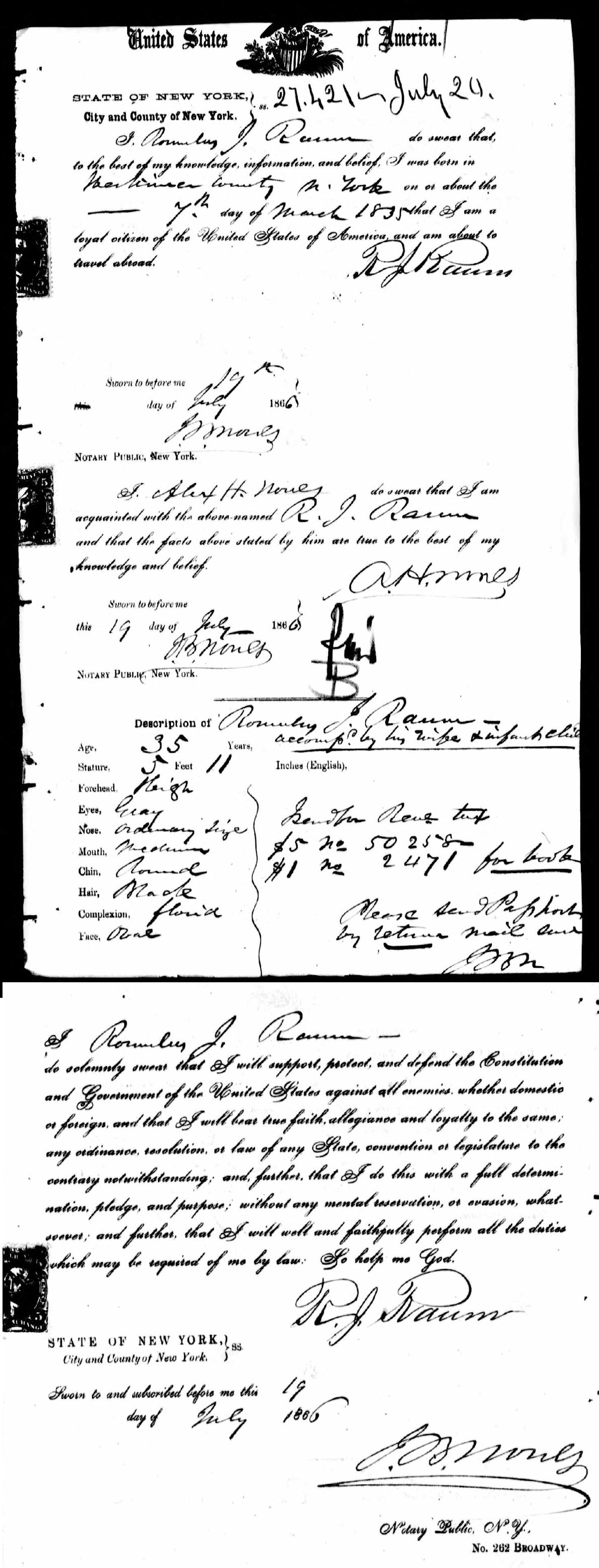 When the war ended, for Romulus John Rhome the South was not south enough. In 1866 Romulus Rhome, his family, and possibly some former slaves moved to Santarem, Brazil. This is Romulus Rhome’s passport application.
When the war ended, for Romulus John Rhome the South was not south enough. In 1866 Romulus Rhome, his family, and possibly some former slaves moved to Santarem, Brazil. This is Romulus Rhome’s passport application.
The Rhomes were not alone in their southern migration. After the South lost the Civil War, an estimated 10,000-20,000 southerners, unwilling to live under Union rule, migrated to Brazil, many of them to Santarem on the Amazon River. Many returned to the United States after Reconstruction ended, but even today in Brazil their descendants, the Confederados, are an ethnic subgroup.
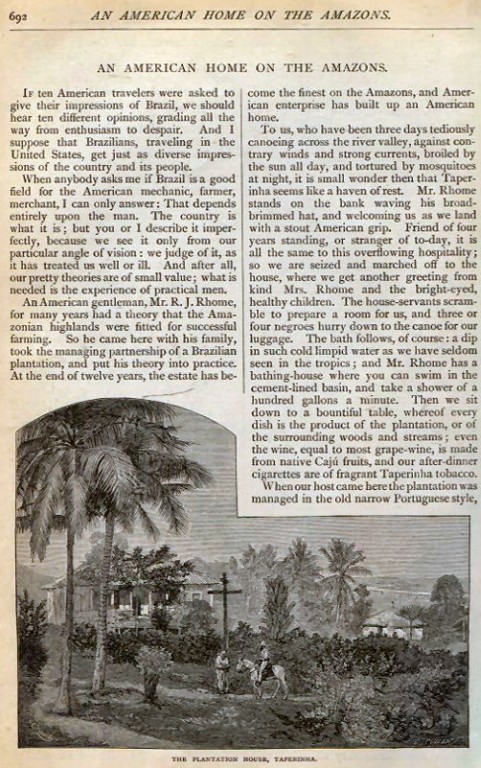 In Brazil Rhome became a successful sugarcane and tobacco farmer. He also distilled rum from his sugarcane and collected archeological artifacts of local indigenous cultures. Scribner’s magazine in 1879 printed fourteen pages on Rhome’s Taperinha plantation.
In Brazil Rhome became a successful sugarcane and tobacco farmer. He also distilled rum from his sugarcane and collected archeological artifacts of local indigenous cultures. Scribner’s magazine in 1879 printed fourteen pages on Rhome’s Taperinha plantation.
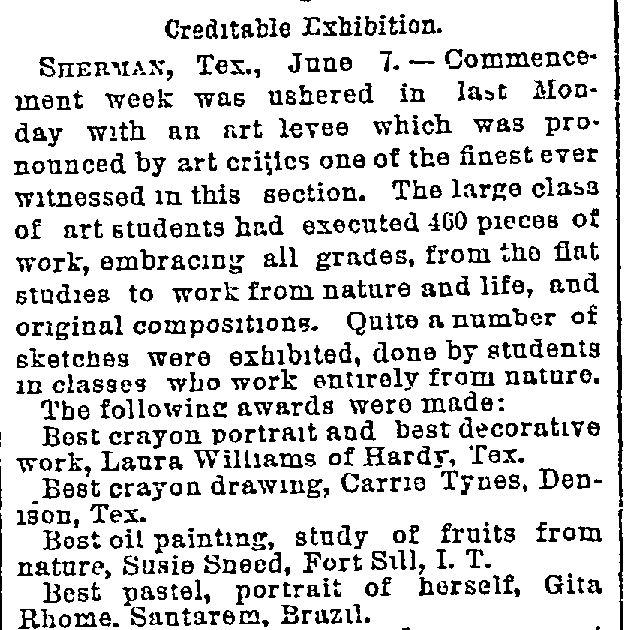 Romulus Rhome’s children, such as daughter Gita, were sent back to the States only for education. His wife, Missouri, died on the plantation in 1884. Romulus died there in 1892. One account says he was shot by rebels after the overthrow of emperor Pedro II, who had offered U.S. citizens—especially farmers—subsidies and tax breaks to immigrate.
Romulus Rhome’s children, such as daughter Gita, were sent back to the States only for education. His wife, Missouri, died on the plantation in 1884. Romulus died there in 1892. One account says he was shot by rebels after the overthrow of emperor Pedro II, who had offered U.S. citizens—especially farmers—subsidies and tax breaks to immigrate.
Romulus Rhome had a brother named not “Remus” but rather . . .
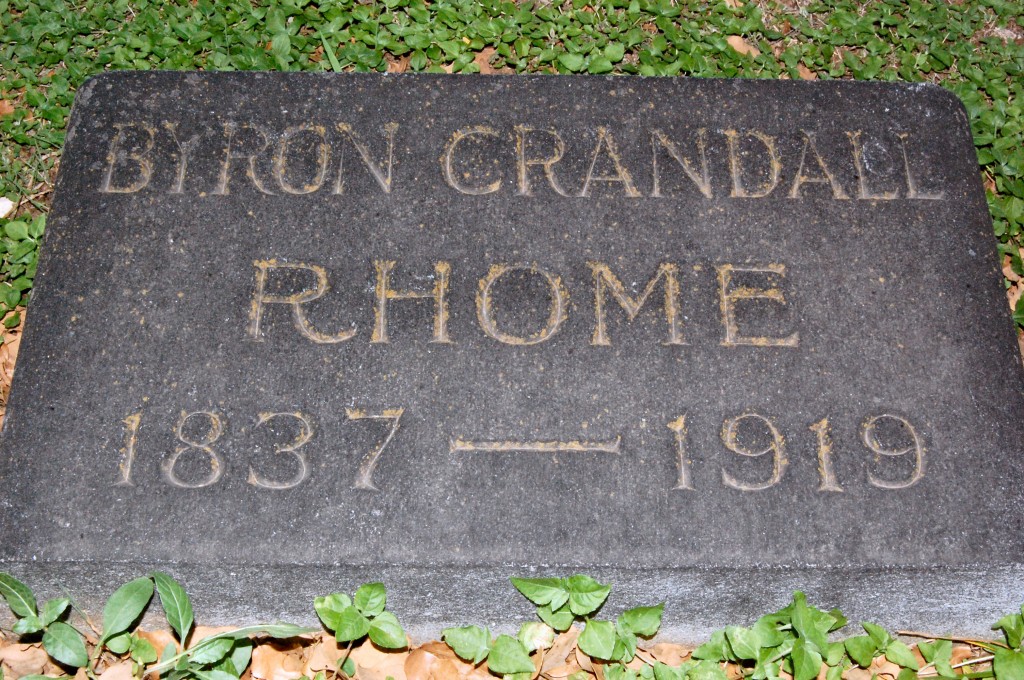 “Byron Crandall.” He was born in 1837.
“Byron Crandall.” He was born in 1837.
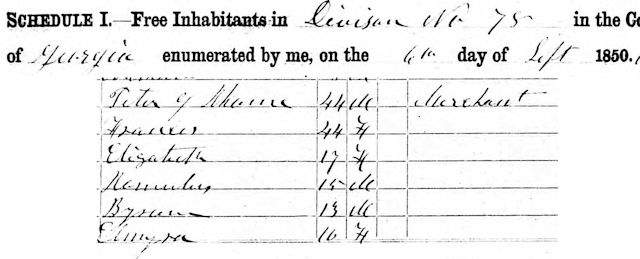 Byron was born in Georgia. Father Peter’s first wife, Nancy, had died in 1840.
Byron was born in Georgia. Father Peter’s first wife, Nancy, had died in 1840.
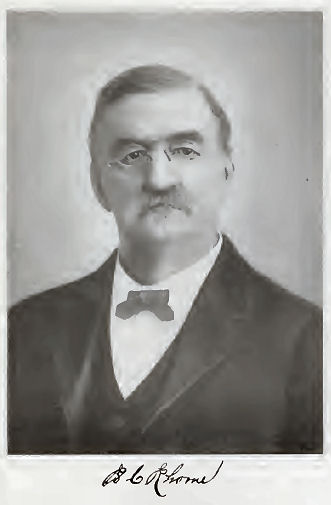 Byron Crandall Rhome in 1864 married Ella Elizabeth Loftin in Cherokee County. When the Civil War began, Byron, like his brother, joined the Confederate army. He enlisted in the 18th Texas Infantry in 1862 and served in General Walker’s division. Byron fought in the battles of Mansfield, Opelousas, and Pleasant Hill in Louisiana and in the Battle of Jenkins’ Ferry in Arkansas. In 1879 Byron and Ella moved to Wise County, near the settlement of Prairie Point. Prairie Point, located at the crossroads of two stagecoach routes, had been settled in the late 1850s by migrants from Missouri. By the early 1860s Prairie Point had a hotel, a school, and a post office and was the second-largest town in Wise County. But during the Civil War the area, defended only by the very young and very old, had been left vulnerable to attacks by Native Americans and outlaws.
Byron Crandall Rhome in 1864 married Ella Elizabeth Loftin in Cherokee County. When the Civil War began, Byron, like his brother, joined the Confederate army. He enlisted in the 18th Texas Infantry in 1862 and served in General Walker’s division. Byron fought in the battles of Mansfield, Opelousas, and Pleasant Hill in Louisiana and in the Battle of Jenkins’ Ferry in Arkansas. In 1879 Byron and Ella moved to Wise County, near the settlement of Prairie Point. Prairie Point, located at the crossroads of two stagecoach routes, had been settled in the late 1850s by migrants from Missouri. By the early 1860s Prairie Point had a hotel, a school, and a post office and was the second-largest town in Wise County. But during the Civil War the area, defended only by the very young and very old, had been left vulnerable to attacks by Native Americans and outlaws.
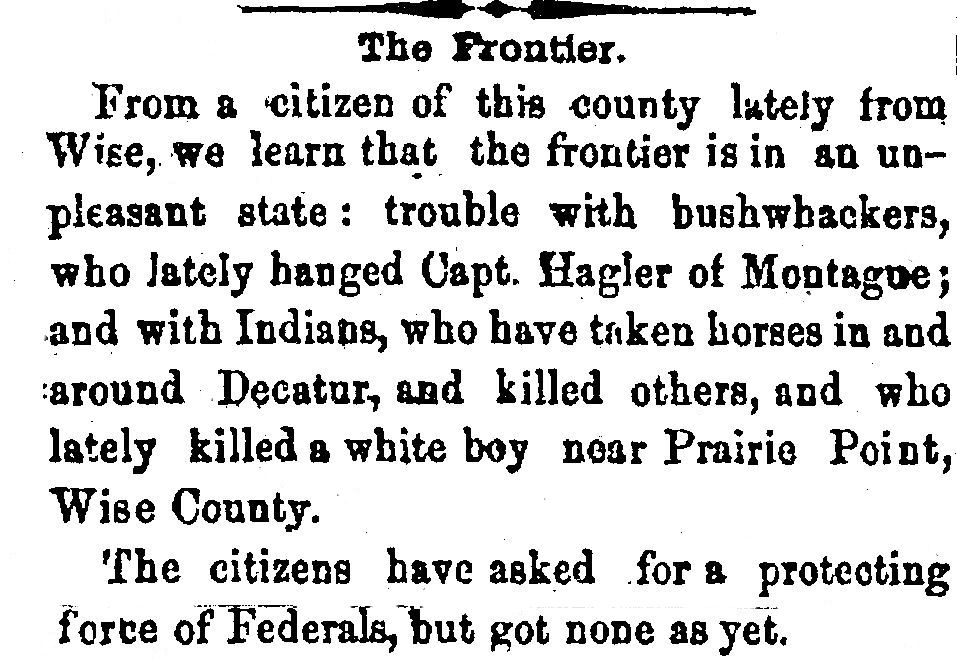 By the end of the war Prairie Point was flirting with ghost town status. This Clarksville Standard article is from 1865.
By the end of the war Prairie Point was flirting with ghost town status. This Clarksville Standard article is from 1865.
But then Byron Rhome arrived in Wise County and began to breed Hereford cattle on his ranch, Hereford Park. His ranching operation was successful. And his success was Prairie Point’s success. Then came more good news for the community: In 1882 Rhome convinced the Fort Worth & Denver City Railway to lay tracks nearby. Soon the dying town of Prairie Point was back on the map. In 1883 the rejuvenated Prairie Point was renamed “Rhome” to honor the man who helped bring the railroad to town and whom the Star-Telegram called the “best-known breeder of pure Hereford cattle in the Southwest.”
A former ranch hand recalled that after the railroad came to town, Byron Rhome decided that his namesake town also needed a post office. But Byron could not convince the postmaster in Decatur to relocate to Rhome. So, finally, after a few drinks one night, Byron and some of his ranch hands drove a large wagon to Decatur, loaded the small post office building onto the wagon, and hauled it, lock, stock, and stamps, back to their town. The people of Decatur, of course, soon reclaimed their post office, but the town of Rhome got its own post office soon after.
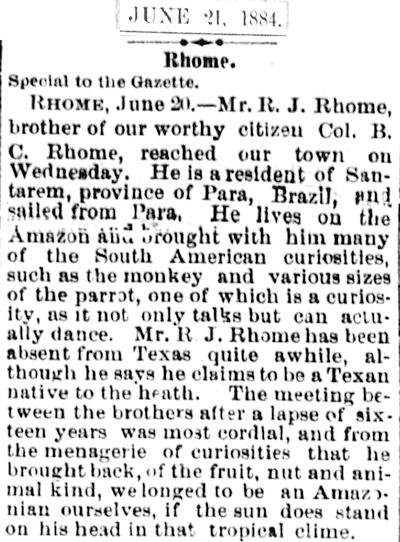 Brazil came to Rhome in 1884 when Romulus, accompanied by some of the native fauna, visited Bryon.
Brazil came to Rhome in 1884 when Romulus, accompanied by some of the native fauna, visited Bryon.
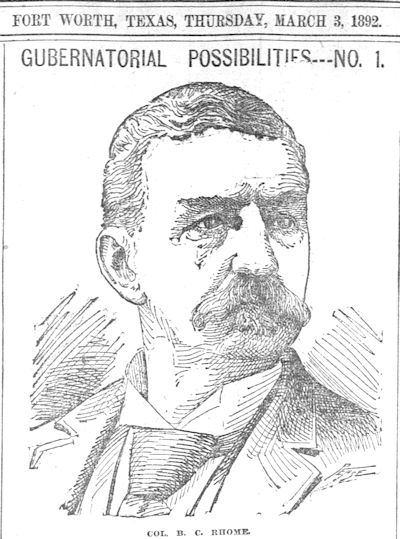 B. C. Rhome was considered to be a possible gubernatorial candidate in 1892.
B. C. Rhome was considered to be a possible gubernatorial candidate in 1892.
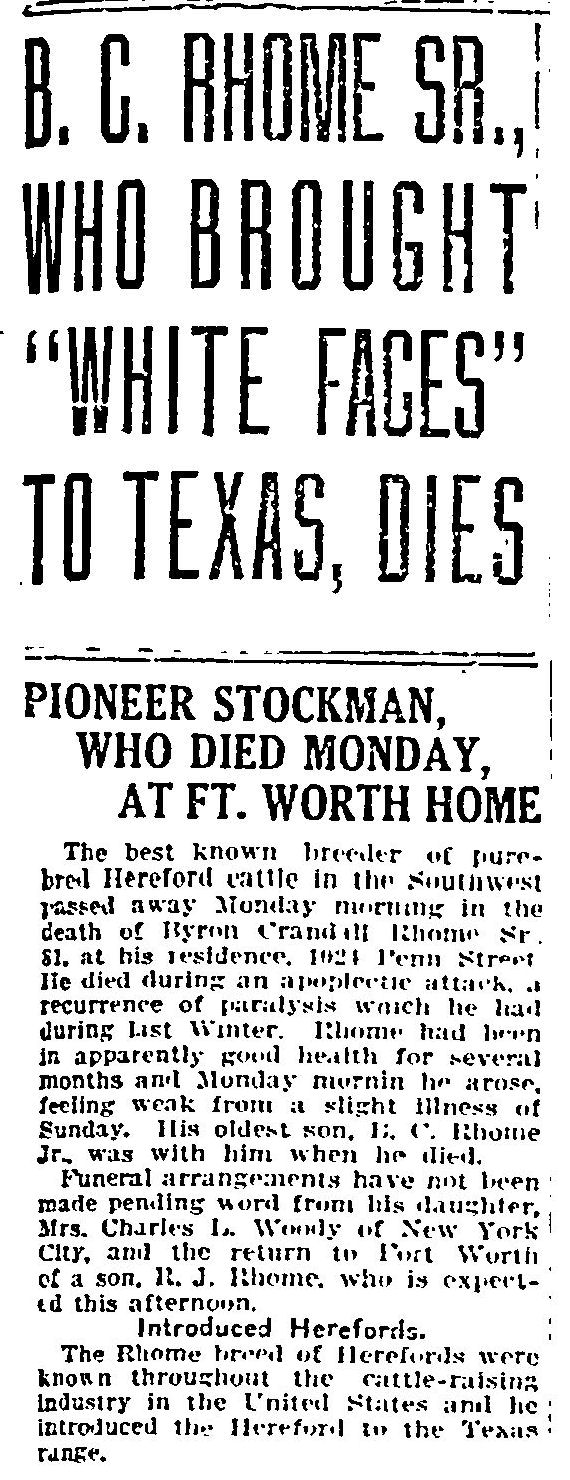 Byron Crandall Rhome moved to Fort Worth in 1896. He died on November 10, 1919 and is buried in Oakwood Cemetery in the Rhome family plot near Romulus John.
Byron Crandall Rhome moved to Fort Worth in 1896. He died on November 10, 1919 and is buried in Oakwood Cemetery in the Rhome family plot near Romulus John.
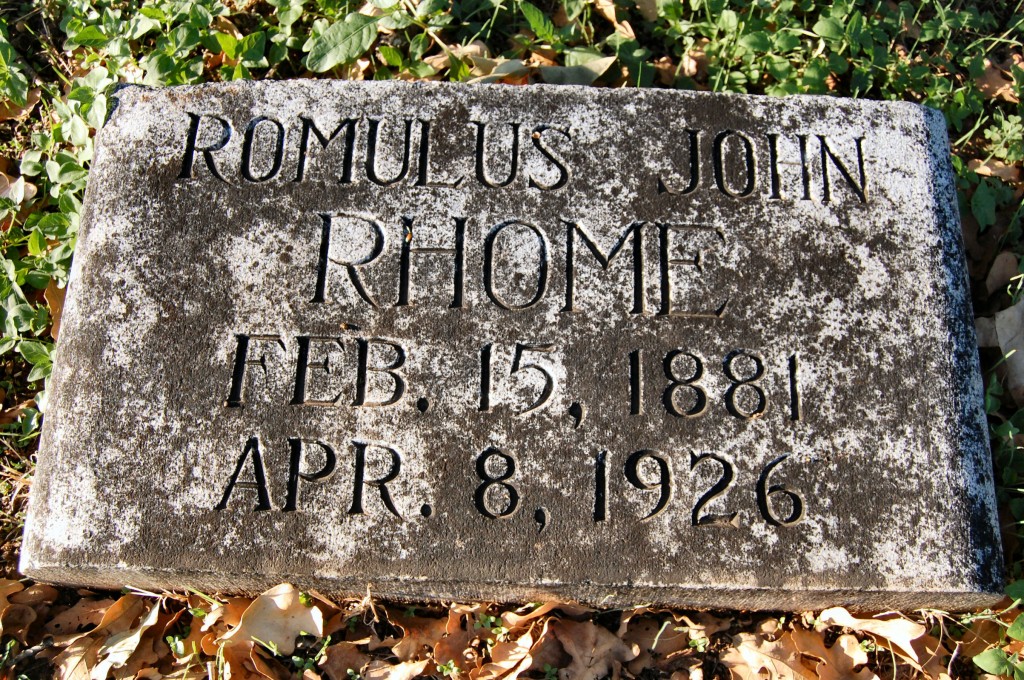 Ah, but the story told by the tombstone has a twist. Romulus John Rhome (1881-1926) who is buried in Oakwood Cemetery was the son of, not the brother of, Bryon Crandall Rhome. Bryon named his son after his brother.
Ah, but the story told by the tombstone has a twist. Romulus John Rhome (1881-1926) who is buried in Oakwood Cemetery was the son of, not the brother of, Bryon Crandall Rhome. Bryon named his son after his brother.
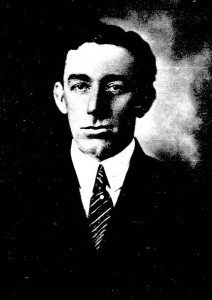
 The younger Romulus John Rhome was a Fort Worth attorney, banker, and cattleman.
The younger Romulus John Rhome was a Fort Worth attorney, banker, and cattleman.
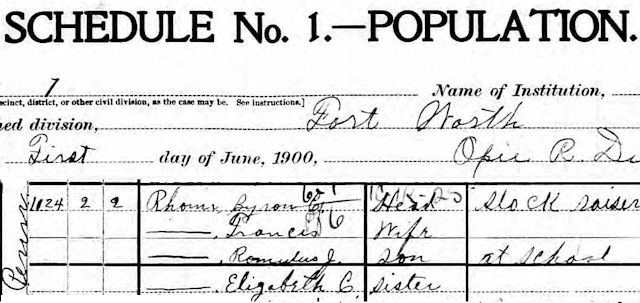 Father and son lived on Penn Street on Quality Hill.
Father and son lived on Penn Street on Quality Hill.





